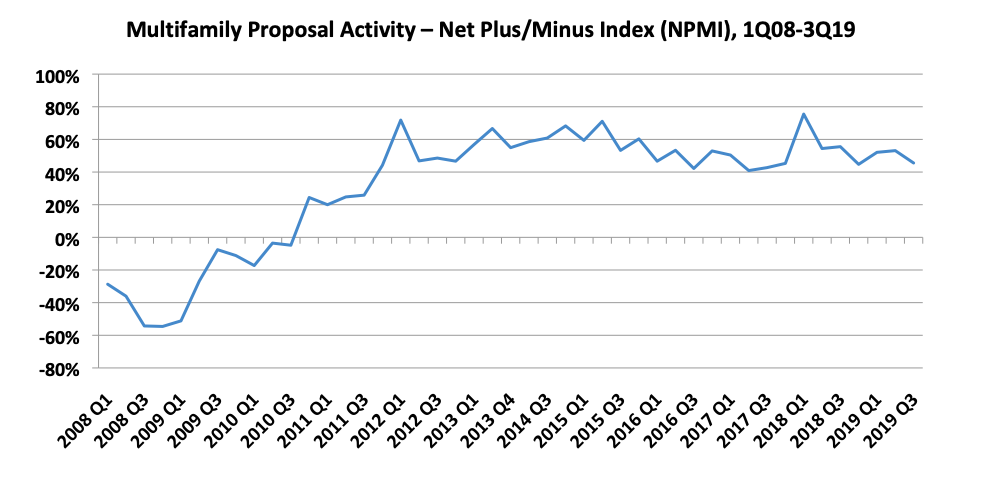Multifamily housing will remain a robust market for A/E/C companies heading into 2020, according to the most recent results of PSMJ’s Quarterly Market Forecast (QMF) survey. For the third quarter of 2019, the survey found that less than 9% of the nearly 100 respondents doing multifamily work reported a decrease in proposal activity compared with the prior quarter, while more than 54% saw an increase.
The Multifamily market’s third quarter Net Plus/Minus Index (NPMI) of 46% marked the 31st consecutive quarter that the submarket exceeded an NPMI of 40%. The last time it was below that level was the third quarter of 2011.
PSMJ’s NPMI measures the difference between the percentage of firms reporting an increase in proposal activity and those reporting a decrease, quarter over quarter. PSMJ has been using the QMF as a predictor of the A/E/C industry’s health since 2003, tracking 12 major markets and 58 submarkets every three months. The company chose proposal activity to gauge the industry’s long-term outlook because it is among the earliest stages of the project lifecycle. Approximately 200 firms participate in the survey each quarter.

The Senior and Assisted Living submarket also performed well with a third-quarter NPMI of 49%. Only 4 of the 86 responding firms working in the senior care submarket reported declining proposal activity. The Senior/Assisted Living market has also been a consistently stellar performer in the QMF. Its NPMI hasn’t dipped below 50% since the fourth quarter of 2012.
“Multifamily and Senior/Assisted Living have been two of the hottest markets for proposal activity for quite some time, not only among the Housing submarkets, but throughout all 58 submarkets,” says PSMJ’s Greg Hart, a consultant who also oversees the QMF. “It is remarkable that both have seen such steady proposal growth for so long. Very few submarkets have been this consistently strong throughout the 16-year history of our survey.”
Housing (all submarkets) recorded an NPMI of 40% in the third quarter, a potentially noteworthy drop from the 59% recorded in the second quarter. After ranking the second-highest of the 12 major markets measured in the second quarter, Housing fell completely out of the top five in the third quarter. Transportation (49%) and Healthcare (46%) were tops among major markets.
Among the other Housing submarkets, Condominiums recorded a respectable NPMI of 24%, its sixth consecutive quarter in the mid-20% range. Individual single-family homes (15%) and subdivisions (8%) trailed the Housing field in the third quarter, falling markedly from 25% and 23%, respectively, in the second quarter. PSMJ Director and Senior Consultant Dave Burstein, PE, notes that the results are still positive, if potentially troubling in the longer term. He adds that lower mortgage interest rates on the horizon are likely to spur a rebound in the single-family and subdivision subsectors.
PSMJ Resources, Inc., based in Newton, Massachusetts, is a publishing, executive education, and advisory company dedicated to serving architecture, engineering and construction (A/E/C) organizations worldwide.
Related Stories
Urban Planning | Jun 15, 2023
Arizona limits housing projects in Phoenix area over groundwater supply concerns
Arizona will no longer grant certifications for new residential developments in Phoenix, it’s largest city, due to concerns over groundwater supply. The announcement indicates that the Phoenix area, currently the nation’s fastest-growing region in terms of population growth, will not be able to sustain its rapid growth because of limited freshwater resources.
Multifamily Housing | Jun 15, 2023
Alliance of Pittsburgh building owners slashes carbon emissions by 45%
The Pittsburgh 2030 District, an alliance of property owners in the Pittsburgh area, says that it has reduced carbon emissions by 44.8% below baseline. Begun in 2012 under the guidance of the Green Building Alliance (GBA), the Pittsburgh 2030 District encompasses more than 86 million sf of space within 556 buildings.
Industry Research | Jun 15, 2023
Exurbs and emerging suburbs having fastest population growth, says Cushman & Wakefield
Recently released county and metro-level population growth data by the U.S. Census Bureau shows that the fastest growing areas are found in exurbs and emerging suburbs.
Engineers | Jun 14, 2023
The high cost of low maintenance
Walter P Moore’s Javier Balma, PhD, PE, SE, and Webb Wright, PE, identify the primary causes of engineering failures, define proactive versus reactive maintenance, recognize the reasons for deferred maintenance, and identify the financial and safety risks related to deferred maintenance.
Mixed-Use | Jun 12, 2023
Goettsch Partners completes its largest China project to date: a mixed-used, five-tower complex
Chicago-based global architecture firm Goettsch Partners (GP) recently announced the completion of its largest project in China to date: the China Resources Qianhai Center, a mixed-use complex in the Qianhai district of Shenzhen. Developed by CR Land, the project includes five towers totaling almost 472,000 square meters (4.6 million sf).
Mixed-Use | Jun 6, 2023
Public-private partnerships crucial to central business district revitalization
Central Business Districts are under pressure to keep themselves relevant as they face competition from new, vibrant mixed-use neighborhoods emerging across the world’s largest cities.
Multifamily Housing | Jun 6, 2023
Minnesota expected to adopt building code that would cut energy use by 80%
Minnesota Gov. Tim Walz is expected to soon sign a bill that would change the state’s commercial building code so that new structures would use 80% less energy when compared to a 2004 baseline standard. The legislation aims for full implementation of the new code by 2036.
Student Housing | Jun 5, 2023
The power of student engagement: How on-campus student housing can increase enrollment
Studies have confirmed that students are more likely to graduate when they live on campus, particularly when the on-campus experience encourages student learning and engagement, writes Design Collaborative's Nathan Woods, AIA.
Multifamily Housing | Jun 1, 2023
Income-based electric bills spark debate on whether they would harm or hurt EV and heat pump adoption
Starting in 2024, the electric bills of most Californians could be based not only on how much power they use, but also on how much money they make. Those who have higher incomes would pay more; those with lower incomes would see their electric bills decline - a concept known as income-based electric bills.
Multifamily Housing | May 30, 2023
Boston’s new stretch code requires new multifamily structures to meet Passive House building requirements
Phius certifications are expected to become more common as states and cities boost green building standards. The City of Boston recently adopted Massachusetts’s so-called opt-in building code, a set of sustainability standards that goes beyond the standard state code.

















